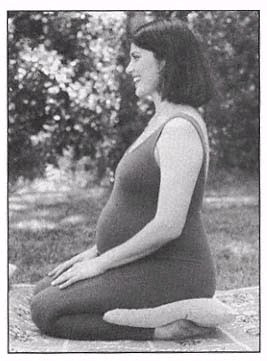Choosing Waterbirth: Reclaiming the Sacred Power of Birth (8 page)
Read Choosing Waterbirth: Reclaiming the Sacred Power of Birth Online
Authors: Lakshmi Bertram,Sandra Amrita McLanahan,Michel Odent

Page 51
time while the baby is lying in your arms and breast or bottlefeeding. The symptoms of "nurser's syndrome" are headaches, neck pain, upper back and shoulder pain, rounded or hunched back, aching arms, and irritability. Palliating these are neck and shoulder rolls that strengthen, stretch, and tone the muscles in the affected region.
HalfSpinal Twist:
Remain in your crosslegged position. Inhale; then as you exhale, bring your left hand to your right knee, turn your upper body to the right and look over your right shoulder. Place your right hand or fingertips on the floor behind you at the base of your spine, completing the twist. While in the pose, breathe deeply and really relax into it, twisting a little further on your exhalation. Always be careful not to push yourself too far. Hold this position for 20 to 25 seconds, then inhale, and as you exhale, turn back to center. Twist to the left by inhaling; on your exhalation, turn your body to the left, grasping your left knee with your right hand.
Look over your left shoulder as your left hand comes to rest at the base of your spine behind you. Hold for 20 to 25 seconds. Inhale, exhale, and return to center.
BENEFITS: This stretch increases the mobility of the spine and gives a gentle massage to the liver, kidneys, and adrenals, improving their ability to function properly. It also helps to correct the posture and to relieve tension carried between the shoulder blades.


Page 52
Cleansing Breath:
Inhale as deeply as you can. On your exhalation, open your mouth and let the air rush out. As you do this, incorporate a sound: for instance,
"Ahhhh." Inhale, and as you exhale say, "Ahhhh." Any open sound may be used, such as "Ohhhh'' or "Uuuuu." Let the sound be open and loose, coming through a relaxed mouth and jaw. You may raise your arms on the inhalation, letting them drop on the exhalation as a variation. Repeat this breath one to three times.
BENEFITS: The cleansing breath allows you to release any tension you may have built up during the pose, and is also deeply relaxing. Taking such a deep breath causes your collarbones to rise. This releases a chemical into your brain telling your body to relax. Doing this breath any time you feel tension or stress will make you feel more relaxed. We will be doing a number of cleansing breaths throughout the class, but it can also be done anytime in your day that you feel stress or tension.
Stretch and Roll:
Whenever your legs become tight or uncomfortable in your seated position, you may stretch them out in front of you and roll them from side to side.
BENEFITS: This will release any builtup tension in your hips and legs.


Page 53
Diamond Pose:
Come up onto your knees into a kneeling position. Make sure your knees and feet are close together. Allowing your toes to remain together, let your heals fall apart. Sit back on your heels. As a variation, place a pillow on your feet and under your buttocks, and sit back on the pillow. Sit in this position for 45 to 60
seconds.
BENEFITS: The diamond pose lifts and opens the diaphragm, giving you more "room" as your abdomen expands, making it a good position to sit in frequently during the first three months when nausea and indigestion ("morning sickness") can cause so much discomfort. It also helps the blood from the legs to return to the heart, and helps to prevent edema (water retention) in the legs.



Page 54
Cat/Cow:
Sit forward on all fours in the "table" position. See that your back is straight and that your knees and hands are directly under your hips and shoulders and about shoulder width apart. Inhale; as you exhale, slowly tuck your pelvis under, arching your back and bringing your chin down to your chest. Exhale fully.
Now, inhale, opening back up the other way; tilt your pelvis up and your belly towards the floor as your head raises up to look toward the ceiling. Repeat eight to ten times each way, gradually increasing this number as you feel comfortable. Come out of the pose by sitting back onto your heels in the diamond position.
CAUTION:
While performing the cat/cow, it is very important that you do not dip your belly down too far, as this could cause you to pull the ligaments on either side of your lower abdomen. As opposed to trying to dip deep, think instead of elongating your spine in both directions and making a gentle curve with your back.
Variation:
Coming back into the table position, elongate your spine; inhale, and as you exhale, bring your right shoulder and your right hip towards each other; look over your right shoulder back to your hip, making a C curve with your body. Inhale and


Page 55
come back to center. Exhale and bend to the left. As you do this make sure to keep your back flat and your spine elongated. Repeat eight to ten times.
BENEFITS: Both the traditional cat/cow and its variation relieve tension in your lower back and in the rest of your spine by keeping them flexible and relaxed. This position takes the pressure of the growing baby off the pelvic floor, easing tension and giving those muscles a wellneeded break. It strengthens the sides of the waist and the muscles of the lower back and abdomen.
Folded Pose
: Sitting back onto your heels again as in the diamond pose, inhale, raise your arms above your head, and stretch.